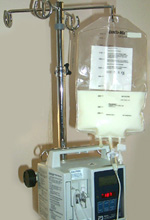Intravenous (IV) Feeding
What is intravenous (IV) feeding?
Intravenous (IV) feedings are given to patients who are unable to tolerate tube feedings. Similar to tube feedings, the intravenous feeding provides the patient with the complete amount of protein, carbohydrate, fat, and vitamins. If the intravenous feeding has fat added to it, it looks white (as shown in the picture to the right).
How are IV feedings given to the patient?
Intravenous feeding will be seen at the bedside hanging from an IV pole infusing through an IV pump. The medical staff refers to intravenous feedings as TPN (total parenteral nutrition) or PPN (peripheral parenteral nutrition). TPN must be given through a central venous catheter and the PPN may be given through a regular IV. Intravenous feedings are given through an intravenous (IV) infusion pump to assure that the patient receives the exact amount of nutrition that the dietician and doctor ordered.
Does the process of IV feeding hurt?
No. Patients usually do not know that they are receiving intravenous feeding unless they are told.
Are there any potential complications associated with use of IV feeding?
The potential complications of intravenous feedings include fluid and electrolyte imbalance. Patients receiving intravenous feedings may be at increased risk for infection. IV feedings may temporarily irritate liver function.
 Intravenous feeding (total parenteral nutrition - TPN)
Intravenous feeding (total parenteral nutrition - TPN)